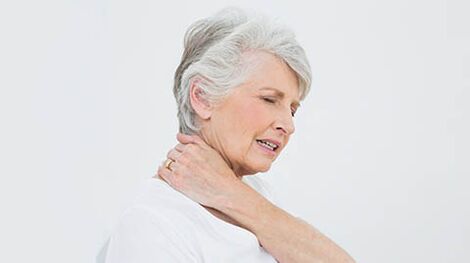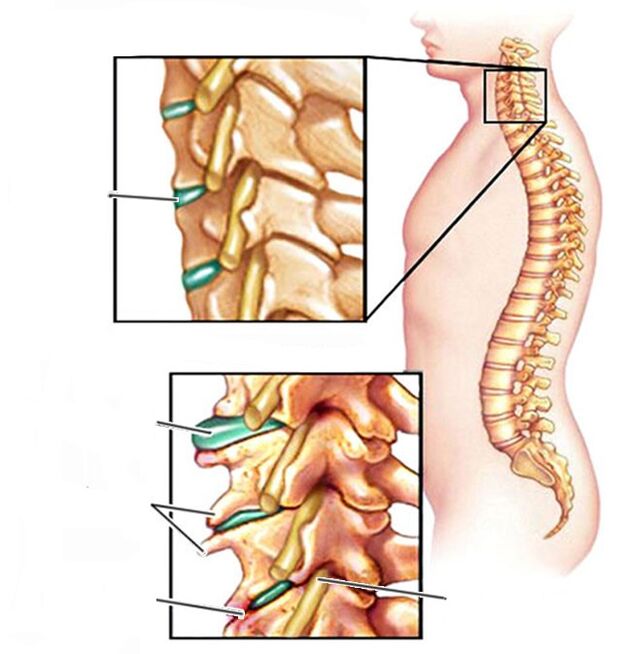The diagnosis of cervical osteochondrosis is made on the basis of simple studies - X-rays. An integrated approach to the treatment of cervical osteochondrosis is needed for disease retreat.
An integrated approach to the treatment of cervical osteochondrosis is needed for disease retreat.
Why does cervical osteochondrosis appear?

Pain has several localization focuses: neck, head, shoulders. Weakened neck muscles provoke the development of osteochondrosis. Due to improper posture, inactivity and unnatural posture, some neck muscles are constantly tense, others spend too much time resting. The spine adapts to irrational loading at the cost of health. The following changes are recorded in cervical osteochondrosis:
- violation of blood and lymph flow;
- lack of nutrition of connective tissue of intervertebral discs;
- instability of the relative position of the vertebral bodies.
The structures of the vertebrae and discs are gradually destroyed. This process is irreversible, so you need to take care of your health in a timely manner and treat the symptoms of osteochondrosis of the cervical spine immediately, postponing it later. The reasons also include:
- neck injuries;
- overweight;
- connective tissue dysplasia;
- poor nutrition, insufficient water intake.
Cervical spine osteochondrosis: symptoms
Main signs (vertebrae):
- Pain. This can be a constant pull, or it can occur in periods following the static position of the neck, sleeping in an awkward position. There are sharp pains that make the patient immobile for a short time (lumbago);
- Torticollis or heavy movement. Sometimes turning or tilting the head is so painful that one finds a comfortable position in which the pain is minimal and tries to stay in it;
- Feeling of muscle tension, stiffness, heaviness;
- Cracking of the vertebrae when the head is turned. Extravertebral symptoms of cervical osteochondrosis (involving nerves and surrounding tissues);
- Inflammation of the muscles;
- Headache, migraine, dizziness, sometimes with nausea and vomiting;
- Pain in the back of the head, increased intracranial pressure, heavy head sensation; such symptoms are sometimes so pronounced that the term "head osteochondrosis" has taken root among patients. Obviously, headache is only a secondary manifestation of pathological changes in the skeletal system, and it is correct to speak of osteochondrosis of the neck and not of the head;
- Disorders of the senses: hearing and sight, speech, ringing in the ear due to lack of nutrition in the brain;
- Pain in the clavicles, arms to the palms;
- Tingling and chills in the neck and arms, sometimes numbness of the fingers;
- Limiting the range of movement of the arms (possibly on one side).
Dangerous consequences of cervical osteochondrosis: treatment is mandatory!
If degenerative changes are not stopped, the following can be added to osteochondrosis:
- radical pain due to nerves flowing out of the spine;
- protrusions and hernias that compress the spinal cord and lead to complete paralysis;
- cervicocranialgia (cervical migraine, dystonic section of vertebral artery syndrome);
- formation of osteophytes on the vertebrae.
Methods for treating cervical osteochondrosis of the spine
It is impossible to cure this disease with drugs. You can only remove the pain syndrome with painkillers. But they always have side effects, so it is only recommended for use in extreme cases. The symptoms and treatment of osteochondrosis of the cervical spine vary from patient to patient and require an individual approach.
Doctors have a rich arsenal of advanced technologies, they can choose the most effective. Effective in the treatment of cervical osteochondrosis and its manifestations:
- grip on the DRX robot - restores the correct position of the vertebrae without the risk of injury;
- shock wave therapy - improves blood and lymph flow to the affected area, restores metabolic processes, relaxes muscles;
- interstitial electrical stimulation - fights the complications of osteochondrosis, relieves pain caused by inflammation of the pinched nerve;
- HILT - laser therapy that immediately relieves pain.
The next stage in the treatment of the symptoms of cervical osteochondrosis is to restore the blood supply and consolidate the correct position of the vertebrae. Rehabilitation can take several sessions and can include physiotherapy, manual therapy, and the use of modern tools. The more closely the patient follows the recommendations of professionals, the greater the effectiveness of the techniques. The last stage is the responsibility of the patient:
- lifestyle and nutrition correction;
- regular movement therapy;
- active life situation and optimism.























